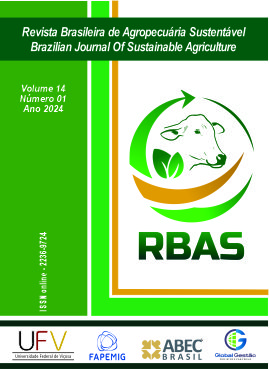DIAZOTROPHIC BACTERIA, YIELD AND GRAIN QUALITY OF WHEAT INOCULATED WITH Azospirillum brasilense AND FERTILIZED WITH BASALT POWDER
DOI:
https://doi.org/10.21206/rbas.v14i01.15848Palavras-chave:
Triticum aestivum, rock dust, rocking, endophytic bacteria, biological nitrogen fixation.Resumo
Brazilian wheat (Triticum aestivum L.) is currently produced mainly with industrialized chemical fertilizers. Biological nitrogen fixation (BNF) and fertilization with basalt powder (BP) are possible alternatives for a more sustainable production. The aim of this study was to evaluate plant growth, yield, grain industrial quality and the amount of endophytic diazotrophic bacteria present in wheat grains inoculated with Azospirillum brasilense and fertilized with basalt powder. Wheat was cultivated under field conditions in the 2018/19 season with the recommended chemical fertilization (NPK) and in residual doses of 40, 80 and 160 t ha-1 of basalt powder. The plots were subdivided, being half inoculated with A. brasilense and other half fertilized with topdressing urea. Shoot dry matter production (SDM), yield, protein content and endophytic bacteria in the grains were determined. Fertilization with basalt powder, regardless of dose, associated with inoculation with A. brasilense resulted in shoot dry matter production, grain yield and protein content equal to NPK. The amount of endophytic bacteria in wheat grains is higher when A. brasilense is inoculated. Alternative fertilization of basalt powder associated with A. brasilense results in yield and grain quality similar to NPK chemical fertilization.
Downloads
Downloads
Publicado
Como Citar
Edição
Seção
Licença
Copyright (c) 2024 Revista Brasileira de Agropecuária Sustentável

Este trabalho está licenciado sob uma licença Creative Commons Attribution-NonCommercial-NoDerivatives 4.0 International License.
1. Proposta de Política para Periódicos de Acesso Livre
Autores que publicam nesta revista concordam com os seguintes termos:
Autores mantém os direitos autorais e concedem à revista o direito de primeira publicação, com o trabalho simultaneamente licenciado sob a Licença Creative Commons Attribution que permite o compartilhamento do trabalho com reconhecimento da autoria e publicação inicial nesta revista.












